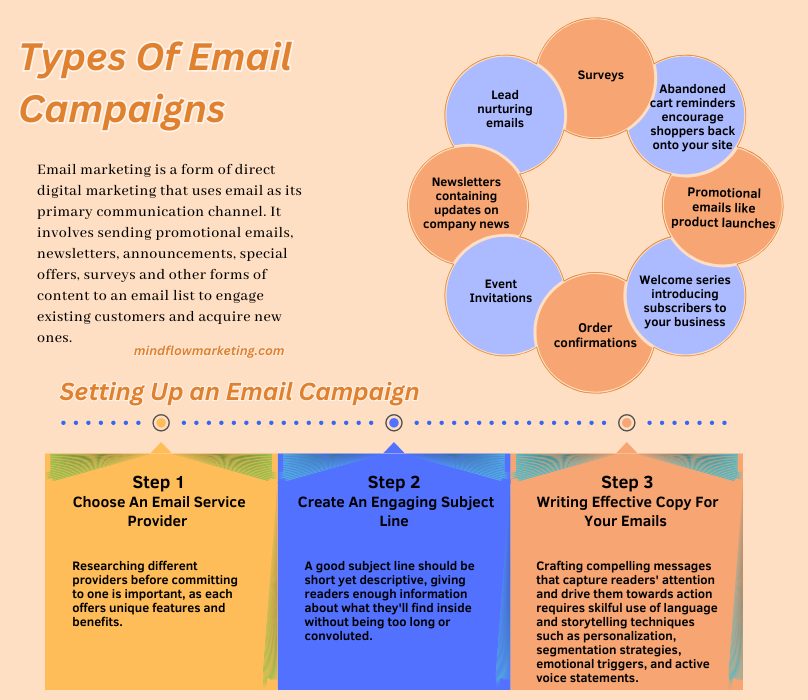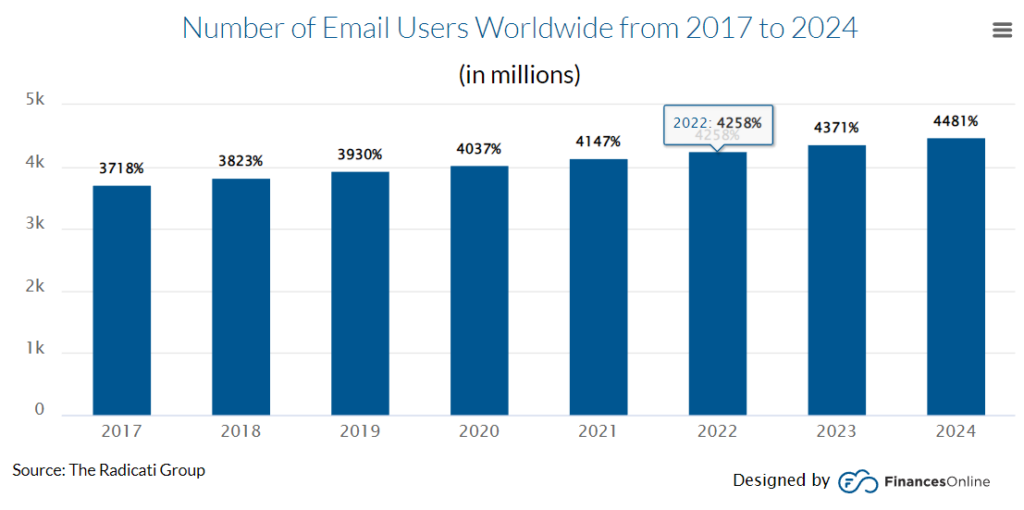Email marketing is a powerful tool for businesses to reach and engage customers. To maximize the success of your email marketing efforts, it is essential to comprehend all facets of this strategy.
From setting up an effective campaign structure to leveraging advanced features such as automation and deliverability testing, many elements must be considered when executing successful email marketing strategies.
This post will delve into the various components that must be considered when creating successful email marketing campaigns, from constructing an efficient setup to taking advantage of sophisticated features such as automation and deliverability testing.

More Resources :
What Is Email Marketing?

Email marketing is a form of direct digital marketing that uses email as its primary communication channel. It involves sending promotional emails, newsletters, announcements, special offers, surveys and other forms of content to an email list to engage existing customers and acquire new ones.
By leveraging the personalization potential of email marketing, businesses can gain valuable insight into their customers’ interests and preferences.
Email is the king of marketing channels, with over 4.5 billion users. Furthermore, email marketing has a return on investment of $36 for every dollar spent, indicating that it belongs in every marketer’s toolbox.
Is Email Marketing Outdated?
Despite the rise of social media, people prefer email to other platforms. After all, what good is marketing to someone if they aren’t present?
According to data, most people use email, which grows yearly.
Furthermore, with email marketing, you own the connections—you don’t have to be concerned about algorithm changes destroying your reach.
Do you still need convincing? According to HubSpot, four out of five marketers would prefer to forego social media over email marketing.
That is why, now more than ever, creating a successful email marketing campaign is critical.
Benefits of Email Marketing
Email campaigns provide businesses with low-performance indicators such as open rates, click-through rates (CTR), and conversion rates, allowing marketers to tailor their strategies for maximum efficiency.
With well-crafted emails tailored specifically for each recipient based on past behavior or preferences, businesses can expect an uptick in engagement compared to traditional advertising methods like print ads or radio spots that often fall on deaf ears.
By leveraging the power of email marketing, companies can ensure their message reaches its intended audience without wasting valuable resources. Look at the below-listed benefits.
Types Of Email Campaigns
There are several types of email campaigns depending on the goal: transactional emails such as:
The possibilities are endless. When constructing a successful strategy, picking the proper type of email campaign that corresponds with its intended goal is essential.
Setting Up an Email Campaign
Creating an email campaign can be straightforward with the right support and resources.
Step 1: Choose An Email Service Provider
The first step is choosing an email service provider that meets your needs and fits within your budget. Researching different providers before committing to one is important, as each offers unique features and benefits. Some offer advanced automation capabilities, while others focus on design or analytics.
Step 2: Create An Engaging Subject Line
Once you’ve chosen a provider, the next step is creating an engaging subject line that will grab people’s attention in their inboxes. A good subject line should be short yet descriptive, giving readers enough information about what they’ll find inside without being too long or convoluted.
Using keywords related to the content of your message can also help boost open rates by helping emails stand out from other messages in crowded inboxes.
Step 3: Writing Effective Copy For Your Emails
Finally, writing effective copy for your emails is essential for successful campaigns. Crafting compelling messages that capture readers’ attention and drive them towards action requires skilful use of language and storytelling techniques such as personalization, segmentation strategies, emotional triggers, and active voice statements.
All these should be employed while avoiding common mistakes like spammy words or phrases that could trigger filters or turn off potential customers/clients. With practice, you’ll soon master this art form and see great results from your campaigns.
Designing Your Emails for Maximum Impact
By following best practices and leveraging advanced features, you can ensure your messages are engaging and effective.
Best Practices for Designing Your Emails
Using Images and Graphics in Your Emails
Images can help draw attention to key points in your message, but ensuring they don’t overwhelm the text or slow down loading times on mobile devices is important. If possible, include descriptive alt text that describes each image so users who have images disabled will still understand its purpose within the context of the message.
Measuring the Success of Your Campaigns
Measuring the success of your email campaigns is essential for understanding how effective they are and improving them over time. Tracking open rates and click-through rates will give you an idea of how many people opened your emails and which links they clicked on.
Gauging ROI and conversion figures can give insight into the fiscal effects of your campaigns while testing different email variations can aid in honing their effectiveness by analyzing which ones work best.
Tracking open rates is a great way to gauge interest in your emails. Measuring the number of people who opened an email in a specified timeframe allows you to determine if the subject line was successful. Click-through rate (CTR) tracks how many people clicked through from the email to visit a website or landing page associated with it – this metric helps determine if readers found what they were looking for in the content itself.
Automating Your Email Campaigns
Automated emailing can be a powerful resource for companies aiming to amplify their communication with customers and extend their reach.
When setting up automated workflows, it’s important to plan, so your messages make sense in the context of the customer journey. Consider how you would like your customers to engage with your content and what steps they should take after receiving your email.
You should also consider any potential triggers, such as purchase history or website activity, that could be used to determine when a message should be sent out.
Effective automated messages require careful consideration of design elements and copywriting techniques. Ensure your subject lines are engaging enough to grab attention but not too long or spammy sounding; aim for around 50 characters or less if possible.
Use visuals like images, GIFs, videos, etc., where appropriate, as these will help draw readers in more than plain text alone would do. Also, ensure that all links within the body of the message point back towards relevant pages on your site rather than external sources – this helps keep people engaged with your brand even after they’ve finished reading your email.
Finally, remember personalization: using data collected from past interactions can help create truly unique experiences for each recipient, which increases the chances of them taking action upon receipt of one of your emails.
Increasing Deliverability and Avoiding Spam Filters
Understanding spam filters and how they work is essential to any email campaign. Spam filters are developed to spot and obstruct emails containing material or designs judged unwelcome, malicious, or improper.
Keyword-based filters detect emails containing words that may indicate an unsolicited, malicious, or otherwise inappropriate message. Additionally, some filters will scan for other features such as poor grammar or formatting issues like too many images or large fonts.
To ensure your messages aren’t caught by these filters, use natural language with proper spelling and grammar when crafting your emails. Avoid using excessive punctuation marks and HTML coding as well.
Strategies to improve deliverability include ensuring you have a valid sender domain name and the IP address associated with each message you send out – this will help prevent it from being flagged as suspicious by anti-spam systems.
You should also ensure you send emails only to those who have opted in to receive them; double opt-in forms can be used here if needed.
Finally, regularly monitor bounce rates, so you know which addresses need updating to keep your lists up-to-date and reduce the chance of blocked messages due to invalid contact information.
Leveraging Advanced Features to Take Your Campaigns to the Next Level
Taking your email campaigns to the next level requires leveraging advanced features. Using personalized elements, dividing up your target audience, and connecting with other services can help elevate customer interaction.
Personalization is key when it comes to engaging customers through email. Using personalization tags in subject lines and body copy, you can create emails tailored specifically for each customer’s interests or needs.
This could include addressing them by name in the subject line or including product recommendations based on their previous purchases.
According to a 2021 report by Litmus, 80% of customers are more likely to purchase a brand that offers personalized experiences. Furthermore, 83% of customers are willing to share their data to provide a more personalized experience.
Segmentation is another important tool for improving customer engagement through email marketing campaigns. Segmenting your lists allows you to send targeted messages based on different criteria such as location, purchase history, age group, etc., which helps ensure that each customer receives relevant and interesting content.
This increases engagement and leads to higher conversion rates since people are more likely to take action when presented with content that speaks directly to their needs or interests.
Integrating other platforms into your emails can help take them up a notch. Integrating an e-commerce store into emails gives customers the convenience of purchasing directly from their inboxes, which can lead to higher sales.
You can also integrate social media buttons so readers can easily share content from within the email itself – which has been proven to lead to higher engagement overall compared with traditional methods like linking out externally instead.
When Is The Best Time To Send A Marketing Email?
Instead of sending emails at random times and days, be strategic. Consider what you know about your audience and the best time to email them.
According to Sendinblue’s research, email marketing campaigns perform better when sent on Tuesdays or Thursdays around 10 a.m. or afternoons around 3 p.m.
However, what works for most people may not work for you. It’s critical to test different times to find the sweet spot for your audience. Alternatively, you can use Sendinblue’s Send Time Optimization feature, which determines the best time to send to each contact based on previous engagement data.
Conclusion
Email marketing is a valuable resource for any enterprise, but it requires commitment and hard work to realize the maximum potential of your campaigns. With the right strategy, tools and resources, you can create successful email campaigns that will help increase engagement with customers and boost sales.
By understanding how to set up an effective campaign, design emails for maximum impact, measure success accurately and leverage advanced features like automation – you’ll be able to maximize your return on investment from email marketing activities.
Improve your email campaigns and optimize deliverability with mindflowmarketing‘s comprehensive tools, guides, and resources suite. Let us help you take control of your email marketing today!
